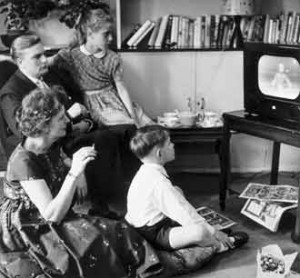Just a few decades ago more than half of young American adults regularly read a daily newspaper. The majority of them also tuned into a nightly news program. Today, a study shows only 8% of young adults would ever consider picking up a newspaper and only 17% regularly watch TV news. While it might be tempting to assume that teenagers must be turning to the Internet for news, the same study shows that only 12.5% of young adults ever visit news websites.
[wpcol_1half id=”” class=”” style=””]A big factor in this decline is the explosion in media choice that has occurred over the past 20 – 30 years. In years past there would have been one television per household, situated in the living room, with only a handful of channels. There were no channels or programs aimed specifically at a youth demographic and teenagers would have been forced to watch whatever their parents watched.There now exists an entire media industry devoted to serving the needs of the teenage demographic. A plethora of television channels and programs, magazines, websites, apps and games exist specifically for the 13–19 year-old market. Despite this ever-expanding teen-media industry there are still very few outlets actually capturing a young adult audience for news.
[/wpcol_1half] [wpcol_1half_end id=”” class=”” style=””]
The 1950s family, with one shared focal source of media all watched together. Image: Paul Townsend[/wpcol_1half_end]
The problem seems to be that producers of factual ‘yoof’ programming tend to dramatically misunderstand their audience. The content seem to be either hyper-edited, tawdry drivel presented by children themselves where the only ‘issues’ up for discussion are those revolving around sex and booze, or desperately over-earnest snooze-fests, endlessly discussing the difficulties faced by young people today.
Both of these options greatly underestimate and patronise their audience. My new TV channel and website, ‘Trending News’, would attempt to redress the balance. Firstly we would aim to tackle the myth that young people are only interested in young people’s issues and will only watch a program if it is presented by someone the same age as them. The main criteria for our journalists will be journalistic skill, knowledge and ability to communicate information to a younger audience.
[wpcol_1half id=”” class=”” style=””]A crucial factor in establishing an audience for ‘Trending’ will be the tone of the output. Our audience of ‘digital natives’ will be used to the more informal and casual tone of YouTube and the Internet. This may be one of the factors putting young people off traditional news programs. A more ‘laid back’ tone akin to that of the US website ‘The Young Turks’ will be adopted to present information in a conversational informal manner that young people are comfortable with.[/wpcol_1half] [wpcol_1half_end id=”” class=”” style=””]The informal style of ‘The Young Turks’[/wpcol_1half_end]
We will not underestimate our audience by focussing solely on soft or celebrity news. International news, politics, the environment and social issues will be extensively covered. It will be important that we provide background information and contextualise the stories for our audience who may not have as much knowledge of the subject as an older viewer. This is something that BBC Radio 1’s ‘Newsbeat’ do well, often providing a ‘guide to…’ a prominent news story. This is not to say that we think our audience is thick or ignorant, but it is important to acknowledge that they may well be new to news and will not have had the lifetime of following current affairs that an older audience would have had.
It will be important that both the channel and website maintain a sense of humour. Research into ‘The Daily Show effect’ has shown an increase in political engagement among young people who watch the satirical show. News and information is presented in an intelligent as well as amusing and humorous way that keeps young people coming back for more.
[wpcol_1half id=”” class=”” style=””]Another factor identified in ‘The Daily Show Effect’ is the use of relevant, concise and informative video clips. The website should have lots of multimedia, appropriate to the story being told. It will be crucial that infographics, video and audio are used throughout the site. We must not, however, simply ‘shovel’ content from the TV onto the web. We can use the website to give our audience as much choice about how they consume our content as possible. A broadcast interview, for example, could be put up online as well as a 2-3 minute edited highlights and a full length ‘uncut’ version.[/wpcol_1half] [wpcol_1half_end id=”” class=”” style=””]Jon Stewart has been credited with engaging millions of young Americans in politics[/wpcol_1half_end]
The website’s staff of ten will consist of many of the traditional roles that you would expect in a newsroom. There will be an editor, subeditor, news editor, international editor and 3 staff writers. Relevant editors will commission copy from freelancers and other journalists within the organisation. The staff writers will be responsible for keeping the site up to date, ensuring that there is new content at least every hour.
There will be one photo/visual editor with the responsibility of making sure the site looks as god as possible. Our audience is incredibly web literate, if our site does not meet their standards, regardless of how good our content is, they will not stick around.
Finally, two of the team will be responsible for our social media presence. Teenagers are heavy users of social media and making sure that we engage with this audience will be crucial in building and maintaining our readership. Developing a Facebook app and other sharing features will be essential. We also need to keep in mind that social media is not just a tool for getting stories to an audience but is incredibly useful as a source and as a tool to develop sources and harness content. The social media team need to be experienced and knowledgeable in this area. If users are moving to a new platform, we need to already be there.




